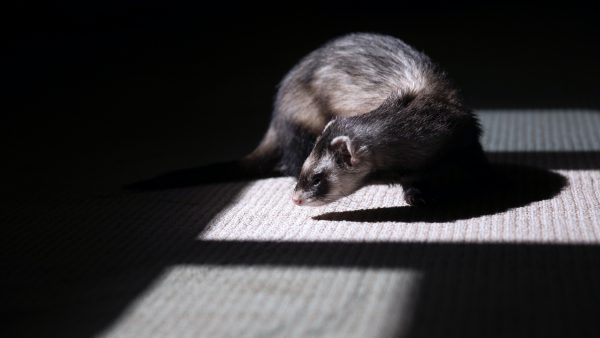Ferret genetics may seem like a mystifying subject, but as you delve into the kaleidoscopic world of coat colors and patterns, you’ll soon discover a fascinating tapestry woven from the threads of their DNA. Imagine the thrill of uncovering the secrets behind the mesmerizing hues of sable, silver, and champagne, or the enchanting charm of roan, blaze, and point patterns. As you embark on this captivating journey, you’ll not only gain a deeper appreciation for these endearing creatures but also uncover valuable insights into responsible breeding practices.

The Science Behind Ferret Genetics
Genetics, the study of heredity and variation in living organisms, reveals the complex interactions between inherited traits and environmental factors. The genetic code found in ferrets’ DNA determines the coat colors and patterns they exhibit, with each parent contributing specific genes that influence their offspring’s appearance.
The Colorful World of Ferret Coat Colors
Albino: This genetic mutation results in a complete absence of pigmentation, giving ferrets a pristine white coat and captivating red eyes. Albinism is a recessive trait, requiring both parents to carry the gene for it to manifest in their offspring.
Sable: Regarded as the quintessential ferret color, sable ferrets boast a rich, dark brown coat with a warm, golden undercoat. The enchanting mask-like markings on their faces add an air of mystique to their appearance.
Champagne: Exuding elegance, champagne ferrets have a delicate cream-colored coat with a soft, silvery hue. Their bewitching burgundy eyes are a stunning contrast to their luxurious fur.
Silver: With a coat that appears to shimmer like precious metal, silver ferrets have a striking appearance. Their fur is a blend of dark and light guard hairs, creating a gorgeous, gleaming effect.
Chocolate: Chocolate ferrets possess a delectable, warm brown coat with a lustrous, reddish undertone. Their alluring dark eyes add to their charm and appeal.
Ferret Coat Patterns: Adding Personality to Their Appearance
Solid: Solid-colored ferrets have a uniform coat with no discernible patterns. Their monochromatic appearance is a testament to the simplicity and beauty of a single hue.
Roan: The roan pattern is a breathtaking masterpiece of nature, with a harmonious blend of colored and white hairs distributed evenly across the ferret’s body, creating a speckled effect.
Point: Point ferrets showcase a striking contrast between their body color and the darker shades on their extremities, such as their ears, legs, and tail. This pattern is reminiscent of the Siamese cat’s coloration.
Blaze: Blaze ferrets exhibit a bold facial pattern, with a distinctive white stripe running from their forehead down to their nose. This eye-catching pattern adds a touch of flair to their appearance.
Mutt: Celebrating diversity, the mutt pattern is a delightful amalgamation of various patterns, creating a unique and whimsical appearance that truly sets each ferret apart.
Inheriting Coat Colors and Patterns: The Role of Ferret Parents
Parental genetics play a crucial role in determining the appearance of ferret offspring. Each parent contributes a set of genes, which can be dominant or recessive, that influence coat color and pattern. However, the inheritance of ferret coat characteristics is often unpredictable, resulting in a plethora of unique and captivating combinations.
The Role of Nutrition and Environment on Ferret Coat Color
Diet and environmental factors can also impact ferret coat colors. Nutritional deficiencies or imbalances may cause a change in fur color or quality. Furthermore, exposure to sunlight or seasonal changes can result in temporary alterations to their appearance.
Ferret Coat Colors and Health Implications
Some coat colors and patterns have been linked to genetic health conditions in ferrets. For example, ferrets with white coat patterns may be more prone to Waardenburg Syndrome, a genetic disorder affecting pigmentation and hearing. It is crucial for ferret owners to be aware of these potential health implications and monitor their pets accordingly.
Caring for Your Ferret’s Unique Coat
Grooming is an essential aspect of maintaining your ferret’s coat, regardless of its color or pattern. Here are some tips for different coat types:
- Regular brushing: Use a soft-bristle brush to gently remove loose hair and prevent matting, especially during shedding seasons.
- Bathing: Ferrets require occasional baths with a mild pet shampoo to maintain their coat’s cleanliness and shine. However, excessive bathing can strip their fur of natural oils, leading to dry skin and a dull coat.
- Nail trimming: Regular nail trimming prevents injuries and ensures your ferret’s comfort while walking and playing.
Dealing with shedding and hair loss
Ferrets, like many other mammals, shed their fur periodically. To minimize the impact of shedding, brush your ferret frequently to remove loose hair and prevent ingestion, which could lead to hairballs. If you notice excessive hair loss or bald patches, consult your veterinarian to rule out any underlying health issues.
Breeding Ferrets for Specific Coat Colors and Patterns
While it may be tempting to breed ferrets for specific coat colors and patterns, it is essential to prioritize responsible breeding practices. Consider the genetic health of the animals involved and focus on maintaining a diverse gene pool to avoid perpetuating health issues. Always prioritize the well-being of your ferrets and make ethical choices when breeding.
The incredible variety of ferret coat colors and patterns is a testament to their uniqueness as a species. Embracing this diversity not only adds visual appeal to our ferret companions but also helps us appreciate the intricacies of their genetics and individuality.
Conclusion
Ferret genetics, coat colors, and patterns are a beautiful and complex aspect of these endearing creatures. Understanding the various factors that influence their appearance enables us to appreciate their individuality and care for them better. As ferret enthusiasts, let us celebrate the beauty and diversity of our furry friends, cherishing their captivating coats and the enchanting personalities that lie beneath.
